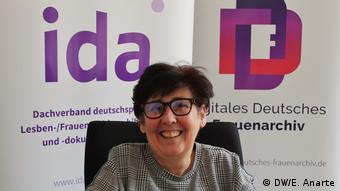As before, lesbians are a frequently overlooked minority. The “Lesbian Visibility Day” is therefore a spotlight on you. The author, Ruth Roellig described the Berlin lesbian scene in the Weimar Republic.

In 1928 Berlin was a city of upheaval. Of all places, was ruled by poverty, insecurity and political polarisation. But at the same time, the German capital freedoms that were once pure utopias have experienced. The fascist Era had not yet dawned, and so strove for women and sexual minorities according to their place in society.
“The Weimar Republic was, above all, in Berlin in an outbreak,” says Sabine Balke, Director of the Digital German women’s archive in the DW-Interview. “Everything was possible.” So at least it seemed to. Because, furthermore, the emancipation of women came across in everyday life, on massive Resistance, were able to cross-dressers on the street, arrested and remained homosexual relationships are criminalized.
Lesbian magazines are an important voice
Lesbians are often regarded as the least perceptible of things group within the LGBTI Community (LGBTI is abbreviation for lesbian, Gay, Bisexual, Transgender, and intersex), got at least an impression of how the society might look like if the rules were different. It was much the work of a woman, the gender recorded at the time, a first map equal, female love and desire:
Ruth Roellig (1878-1969) began writing shortly after graduating. In a male and heterosexual world. Soon, she managed to publish fiction and travel writings. In the Weimar Republic, with at least relative freedom of the press wrote Roellig, your, today is, the most remarkable texts. “For lesbians the loose censorship in the Republic was important. Many new lesbian magazines are published,” explains the historian Laurie Marhoefer. “Garçonne”, “The girlfriend” or “wife love” were some of the magazines, the homo – and bisexual women the opportunity not to only tell their own stories, but to also discover safe spaces and recreational activities, you are forced to hide their sexual orientation.

The magazine “Loving women” – an example for publications of the Weimar period, the female sexuality focused
As the progress seemed irreversible
“You could go in the Clubs, and similar people to meet other lesbian women dancing, making music,” says Balke. It was the time when the also openly gay rebel voice of the cabaret Queen Claire Waldoff was played in the Radios all over the country.
By your article on Mrs love was Roellig, a leading figure in the lesbian scene in Weimar Berlin. The publication of these texts meant in their own Coming-Out. At that time, to be no great danger. The progress must be irreversible feel.
The first queer city guide
1928 Roelligs appeared in the history of lesbian women in Germany. And in “Berlin’s lesbian women” portrayed you in detail the network of the capital with Bars, cafes and Clubs: It was a breaking of queer city guide. And far more than that: “It is an important document for what was there,” stresses Balke. She also directs the Berlin-based lesbian archive the spin the floor and underlines the importance of the book as a historical source. “As women in the 1970s began to fight for a more open sexuality, or against the prohibition of abortion, they did not know that it had been in the 20s already something Similar.”

Sabine Balke, Director of the Digital German women’s archive
The Nazi state began in 1933, this short period of time of sexual emancipation. The new rulers made the magazines, and venues, which were for sexual minorities in the last ten years, so important, dense. Also Roelligs life changed more and more. “She was outed. As a lesbian woman, she was not able to write. You had to be quick to ensure that everything disappeared,” says Balke.
Tainted literary heritage
However, it was not the end of your writing career. Published in 1937, another novel: “soldiers, death of a dancer”. The Share anti-Semitic book stained Roelligs literary heritage. For the American historian Marhoefer, it is Central, this is a controversial page of the pioneer lesbian active involvement of the state: “Every Time we mention them, we must also take into account this part of their heritage. She was in the Nazi time, there is no ‘bystander’”.
Balke agrees, adds, however: “It was a question of Survival. Therefore, we can say simply: she was a Nazi.” For Balke Ruth Roellig first of all, in the utmost danger, after they had openly lived something hated the Regime. However, Balke does not want to exclude the possibility that Roellig also Antisemitin.
For the historian, is not revealed here, what have shown the philosopher Hannah Arendt in her work: “people only have a history, and that they are not only good or only bad.” Whether Roellig really anti-Semitic or not, could no longer be answered, believes Sabine Balke.
As the author in 1969, died in Berlin, she had neither openly anti-Semitic views, nor are they revealed their sexual orientation.

Ruth Roelligs “Berlin’s lesbian women” was launched as a “Purple nights”
What remains of her, are made of their books and articles; the legacy of a woman, the lesbians in Berlin decades before the Stonewall riots and the first pride parades to be visible. At that time you will have been the meaning of “Berlin’s lesbian women are” hardly aware of, believes Sabine Balke. For many years, forget the book, before it was relocated in the 1970s under the title “Purple nights”. Thanks to this book, Balke, “lives Ruth Roellig in our history.”